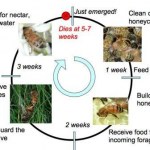clock news
You know I love it, love it, love it, when scientists blog about their own published papers, explaining to the lay audience what they did, how they did it, why they did it, and what it all means. And when this happens in my own field, I take notice! Who am I to explain this new piece of research when Allison can do it so much better? So go and read First, First Author Publication! Effects of Chronic Alcohol on Murine Photic Entrainment for yourself.
As long as we are persistent in our pursuit of our deepest destiny, we will continue to grow. We cannot choose the day or time when we will fully bloom. It happens in its own time.
- Denis Waitley
Whenever I read a paper from Karl-Arne Stokkan's lab, and I have read every one of them, no matter how dense the scientese language I always start imagining them running around the cold, dark Arctic, wielding enormous butterfly nets, looking for and catching reindeer (or ptarmigans, whichever animal the paper is about) to do their research.
If I was not so averse to cold, I'd think this would be the best career in science ever!
It is no surprise that their latest paper - A Circadian Clock Is Not Required in an Arctic Mammal (press release) - was widely covered by the media, both…
Yes, years after I left the lab, I published a scientific paper. How did that happen?
Back in 2000, I published a paper on the way circadian clock controls the time of day when the eggs are laid in Japanese quail. Several years later, I wrote a blog post about that paper, trying to explain in lay terms what I did, why I did it, what I found, and how it fits into the broader context of this line of research. The paper was a physiology paper, and my blog post also focused on the physiological aspects of it.
But then, I wrote (back in March 2006 - eons ago in Web-time) an additional blog post…
That is, among 20 new articles in PLoS ONE today. As always, you should rate the articles, post notes and comments and send trackbacks when you blog about the papers. You can now also easily place articles on various social services (CiteULike, Mendeley, Connotea, Stumbleupon, Facebook and Digg) with just one click. Here are my own picks for the week - you go and look for your own favourites:
Distinct Functions of Period2 and Period3 in the Mouse Circadian System Revealed by In Vitro Analysis:
The mammalian circadian system, which is composed of a master pacemaker in the suprachiasmatic…
I am not the only one on ScienceBlogs.com to write about circadian rhythms, sleep and (non-visual) photoreception. Over the years, my SciBlings have written about these and related topics as well. Here is a sampler - go and dig for more on their blogs.
Stimulant Improves Sleep
Locked-In Syndrome
Opioids and Sleep Disorders
Home Testing for Sleep Apnea?
Pure Hypomanics: Living Zippedy Doo Dah Lives?
SFN Update: Sleep Deprivation Impacts Memory, Reduces Hippocampal Activity
Data Faker Turns Himself In
Agomelatine: A New Approach For Depression
Casual Fridays: Dave FINALLY finishes analyzing the…
If you ever glanced at the circadian literature, you have probably encountered the statement that "circadian rhythms are ubiquitous in living systems". In all of my formal and informal writing I qualified that statement somewhat, stating something along the lines of "most organisms living on or near the Earth's surface have circadian rhythms". Why?
In the earliest days of chronobiology, it made sense to do most of the work on readily available organisms: plants, insects, mammals and birds. During the 20th century, thousands of species of animals, fungi, protists and plants - all living on…
Most people are aware that social insects, like honeybees, have three "sexes": queens, drones and workers.
Drones are males. Their only job is to fly out and mate with the queen after which they drop dead.
Female larvae fed 'royal jelly' emerge as queens. After mating, the young queen takes a bunch of workers with her and sets up a new colony. She lives much longer than other bees and spends her life laying gazillions of eggs continuously around the clock, while being fed by workers.
Female larvae not fed the 'royal jelly' emerge as workers.
Workers perform a variety of jobs in the hive.…
Two interesting new papers in PLoS Biology today:
A Role for the PERIOD:PERIOD Homodimer in the Drosophila Circadian Clock:
The current models of circadian clocks in flies and mammals involve the formation of complexes between clock proteins in the cytoplasm. These complexes are usually heterodimers (that is, made up of two different clock proteins) and appear to enter the nucleus at certain times of the circadian day in order to shut down their own gene expression by deactivating specific transcription factors. After progressive phosphorylation the repressor proteins eventually are degraded…
Circadian Clock: Scientists Model 3D Structures Of Proteins That Control Human Clock:
Researchers at the Scripps Research Institute say they have taken a leap forward in their quest to understand the proteins that control the human circadian clock -- the 24-hour wake-sleep cycle that, when interrupted, can lead to jet lag and other sleep disturbances. Researchers report that they have been able to determine the molecular structure of a plant photolyase protein that is surprisingly similar to two cryptochrome proteins that control the "master clock" in humans and other mammals. They have also…
Nice four articles:
The Gears of the Sleep Clock By Allan Pack:
When people have trouble sleeping--such as, in extreme cases, shift workers--those problems are not always rooted in disturbances in circadian rhythm, argues the University of Pennsylvania's ALLAN PACK. Instead, his studies of sleep have shown that the master clock is only one player in the molecular control of sleep.
Sleep adjusts fly synapses by Bob Grant:
New findings support a controversial hypothesis about the biological role of sleep: Snoozing may be a way for the brain to clear clutter accumulated after a hard day of…
Les Lang at the UNC Medical Center News Office now writes a blog - Hard Science. One recent post immediately caught my eye - Clocking Cancer:
You might say that Dr. Aziz Sancar is trying to clock cancer.
In a nifty double play involving a pair of recent publications in the Proceedings of the National Academy of Sciences (PNAS), the Sarah Graham Kenan professor of biochemistry and biophysics at UNC found in one study that tinkering with the circadian clock can suppress cancer growth, and in the other he and his lab team presented molecular data suggesting why timing just might be everything…
Chemotherapy Most Effective At Time Of Day When Particular Enzyme At Lowest Level:
For years, research has hinted that the time of day that cancer patients receive chemotherapy can impact their chances of survival. But the lack of a clear scientific explanation for this finding has kept clinicians from considering timing as a factor in treatment. Now, a new study from the University of North Carolina at Chapel Hill has suggested that treatment is most effective at certain times of day because that is when a particular enzyme system - one that can reverse the actions of chemotherapeutic drugs…
Two very interesting papers this week:
The Circadian Clock in Arabidopsis Roots Is a Simplified Slave Version of the Clock in Shoots:
The circadian oscillator in eukaryotes consists of several interlocking feedback loops through which the expression of clock genes is controlled. It is generally assumed that all plant cells contain essentially identical and cell-autonomous multiloop clocks. Here, we show that the circadian clock in the roots of mature Arabidopsis plants differs markedly from that in the shoots and that the root clock is synchronized by a photosynthesis-related signal from the…
This EurekAlert title got my attention this morning: Immunity stronger at night than during day:
The immune system's battle against invading bacteria reaches its peak activity at night and is lowest during the day.
Experiments with the laboratory model organism, Drosophila melanogaster, reveal that the specific immune response known as phagocytosis oscillates with the body's circadian rhythm, according to Stanford researchers who presented their findings at the American Society for Cell Biology (ASCB) 48th Annual Meeting, Dec. 13-17, 2008 in San Francisco.
"These results suggest that immunity…
There is a nice article in this month's National Geographic about Light Pollution. Unlike most popular articles on the topic which focus on the visibility of stars - an aesthetic problem - this article focuses on the effect of continuous light on animals and humans:
We've lit up the night as if it were an unoccupied country, when nothing could be further from the truth. Among mammals alone, the number of nocturnal species is astonishing. Light is a powerful biological force, and on many species it acts as a magnet, a process being studied by researchers such as Travis Longcore and Catherine…
Related to this discussion, there is a new interesting study out - Daily rhythms in blood vessels may explain morning peak in heart attacks:
It's not just the stress of going to work. Daily rhythms in the activity of cells that line blood vessels may help explain why heart attacks and strokes occur most often in early morning hours, researchers from Emory University School of Medicine have found. Endothelial cells serve as the interface between the blood and the arteries, controlling arterial tone and helping to prevent clots that lead to strokes and heart attacks, says Ibhar Al Mheid, MD, a…
Totally cool:
Phase Coupling of a Circadian Neuropeptide With Rest/Activity Rhythms Detected Using a Membrane-Tethered Spider Toxin:
The regulation of the daily fluctuations that characterize an organism's physiology and behavior requires coordination of the cellular oscillations of individual "clock" neurons within the circadian control network. Clock neurons that secrete a neuropeptide called pigment dispersing factor (PDF) calibrate, or entrain, both the phase of organismal rhythms and the cellular oscillations of other clock neurons. In this study, we tested the hypothesis that phase of…
If you live in (most places in) the United States as well as many other countries, you have reset your clocks back by one hour last night (or last week). How will that affect you and other people?
One possibility is that you are less likely to suffer a heart attack tomorrow morning than on any other Monday of the year. Why? Let me try to explain in as simple way as possible (hoping that oversimplification will not lead to intolerable degrees of inaccuracy).
Almost all biochemical, physiological and behavioral parameters in almost all (at least multicellular) organisms display diurnal (daily…
In today's PLoS Computation Biology:
Circadian rhythm is universally present from unicellular organisms to complex organisms and plays an important role in physiological processes such as the sleep-wake cycle in mammals. The mammalian circadian rhythm presents an excellent system for studying gene regulatory networks as a large number of genes are undergoing circadian oscillation in their expression levels. By integrating all available microarray experiments on circadian rhythm in different tissues and species in mammals, we identified a set of common circadian genes lying in the center of…

